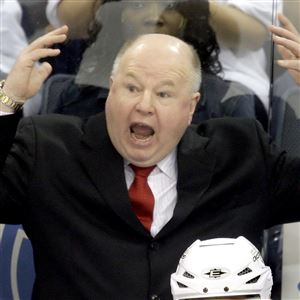ST. PAUL, Minn. — The Penguins did a lot of things really well in their 6-2 loss Friday against Minnesota at Xcel Energy Center.
They made some outstanding turnovers. The kind that show up on the scoreboard a few seconds later.
They were guilty of several genuinely bad decisions.
They did a sensational job of making a lackluster Wild power play look absolutely lethal.
OK, so none of that had been in coach Mike Sullivan’s game plan, but very little that the Penguins did for most of the game was.
They started terribly and, aside from a hiccup of competence in the second period, didn’t stray from that approach very often over the course of the afternoon.
“It just comes with being ready to compete and execute,” center Sidney Crosby said.
The Penguins clearly weren’t prepared to do either.
Charlie Coyle put the Wild in front to stay just 40 seconds after the opening faceoff, when he nudged in the rebound of a Zach Parise shot that had slipped between the pads of Penguins goalie Marc-Andre Fleury. That would be the first of a half-dozen pucks Fleury would pull out of his net.
“Personally, I think I need to make a few more stops,” he said.
That’s a fair self-assessment, but it doesn’t absolve his teammates for the way they played in front of him.
“We left [Fleury] out to dry,” defenseman Brian Dumoulin said.
Sullivan, who had said before the game that he wasn’t concerned about Fleury’s 2-6 career record against Minnesota, didn’t disagree.
“The types of saves he had to make were high-quality,” Sullivan said. “We put him in a tough spot in a lot of the circumstances.”
Especially when the Wild had an extra man. That happened four times, and three of those power plays ended in a Minnesota goal.
The Penguins have given up at least one man-advantage goal in 13 of their 21 games this season and have allowed two or more four times, although Minnesota was the first opponent to get three.
Going into the late games Friday, the Penguins’ short-handed unit was the fourth-worst in the NHL, killing just 77.9 percent of the power plays it has faced.
“Our penalty-kill has to be way better,” Sullivan said. “It’s just simply isn’t good enough.
“We can’t give up a penalty-kill goal-against every game. We gave up three tonight. It’s hard to win.”
Fair enough, although the goal that truly deflated the Penguins – and turned out to be the winner – was scored at even-strength.
They had bounced back, at least somewhat, from their miserable start when Phil Kessel converted an Evgeni Malkin set-up at 13:26 of the opening period to cut Minnesota’s lead to 2-1.
The Penguins seemed poised to reach the intermission with just a one-goal deficit until defenseman Kris Letang threw the puck to Coyle in the right circle. Coyle buried his shot behind Fleury with 22.2 seconds to go, and the final two periods were reduced to a 40-minute formality.
“That third one hurt a little bit,” Fleury said.
Yeah, just a little. Probably not much more than a guillotine, though.
Of course, a few performances like this are inevitable over the course of an 82-game season.
What flusters the Penguins is that they are capable of producing a dominating performance, such as the one Wednesday in their 6-1 victory in New York, then following it immediately with such a wretched effort.
“It’s hard for me to try to explain it,” Sullivan said. “If I could, I could probably solve it.”
He has 61 more games to try.
Dave Molinari: Dmolinari@Post-Gazette.com and Twitter @MolinariPG.
First Published: November 25, 2016, 11:38 p.m.
Updated: November 26, 2016, 1:59 a.m.
















